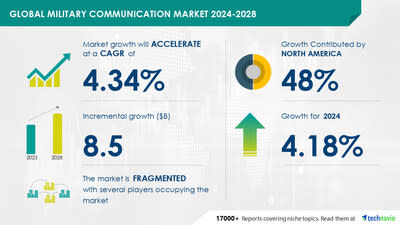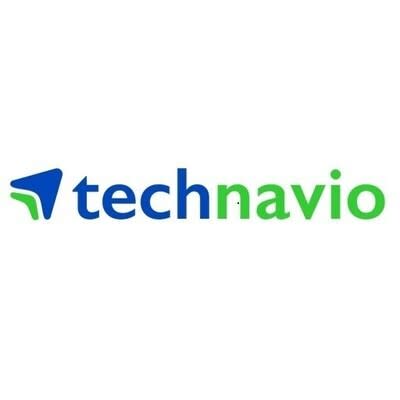AI is Transforming the Military Communication Market, Projected to Grow by USD 8.5 Billion from 2024 to 2028, Driven by Advanced Systems Procurement
NEW YORK, Sept. 26, 2024 /PRNewswire/ -- Report with market evolution powered by AI- The global military communication market size is estimated to grow by USD 8.5 billion from 2024-2028, according to Technavio. The market is estimated to grow at a CAGR of 4.34% during the forecast period. Increasing procurement of advanced military communication systems to strengthen defense communication security is driving market growth, with a trend towards increase in adoption of ai and ml in military communication. However, complexity in radar subsystem upgrades poses a challenge. Key market players include Airbus SE, ASELSAN AS, BAE Systems Plc, Bittium Corp., Cobham Ltd., Elbit Systems Ltd., General Dynamics Corp., Iridium Communications Inc., Kymeta Corp., L3Harris Technologies Inc., Leonardo Spa, Lockheed Martin Corp., Mercury Systems Inc., Nemco Ltd., Nokia Corp., Northrop Grumman Corp., RTX Corp., Spectra Group UK Ltd., Thales Group, and Viasat Inc..
Key insights into market evolution with AI-powered analysis. Explore trends, segmentation, and growth drivers- View the snapshot of this report
Military Communication Market Scope | |
Report Coverage | Details |
Base year | 2023 |
Historic period | 2018 - 2022 |
Forecast period | 2024-2028 |
Growth momentum & CAGR | Accelerate at a CAGR of 4.34% |
Market growth 2024-2028 | USD 8.5 billion |
Market structure | Fragmented |
YoY growth 2022-2023 (%) | 4.18 |
Regional analysis | North America, APAC, Europe, South America, and Middle East and Africa |
Performing market contribution | North America at 48% |
Key countries | US, Russia, China, France, and Germany |
Key companies profiled | Airbus SE, ASELSAN AS, BAE Systems Plc, Bittium Corp., Cobham Ltd., Elbit Systems Ltd., General Dynamics Corp., Iridium Communications Inc., Kymeta Corp., L3Harris Technologies Inc., Leonardo Spa, Lockheed Martin Corp., Mercury Systems Inc., Nemco Ltd., Nokia Corp., Northrop Grumman Corp., RTX Corp., Spectra Group UK Ltd., Thales Group, and Viasat Inc. |
Market Driver
The military communication market is witnessing significant growth due to the increasing adoption of artificial intelligence (AI) and machine learning (ML) technologies. These technologies are revolutionizing military communication by enhancing situational awareness, enabling predictive analysis and threat detection, optimizing resource allocation, providing autonomous systems and decision support, and strengthening cybersecurity. AI and ML algorithms process real-time data from various sources to provide commanders with unparalleled situational awareness, enabling faster and informed decisions. Predictive analysis and threat detection help proactively detect potential risks, while optimized resource allocation ensures efficient use of personnel, equipment, and support services. Autonomous systems and decision support enhance the speed and precision of military operations, reducing cognitive burden on personnel. AI and ML also play a crucial role in cybersecurity by identifying vulnerabilities and deploying countermeasures to protect sensitive military communications and networks. These factors are driving the growth of the military communication market.
Military communication market is witnessing significant trends with the increasing focus on advanced technologies for secure data exchange among military forces. Satellite communication is a key trend, providing real-time data transmission and intelligence sharing among decision-makers and troops. Secure data encryption using high-frequency radio systems and advanced networking protocols ensures the confidentiality of sensitive information. Interoperable communication systems among military forces, allied nations, and armed forces are essential for effective coordination and synergy. Emerging technologies like 5G networks, software-defined radios, and encryption techniques including quantum cryptography, are enhancing military communication systems. Real-time information, sensor data, and intelligence feeds are crucial for situational awareness and target identification. Communication systems with redundancy and disaster recovery capabilities are vital in the operational environment. Military communication systems must be flexible and agile to adapt to cyber threats and evolving defense budgets. Cloud-based solutions and data centralization offer scalability and cost-effectiveness, while advanced communication systems ensure real-time updates and bandwidth capacity. The complexity of military communication requires integration of various systems and data management for efficient coordination.
Request Sample of our comprehensive report now to stay ahead in the AI-driven market evolution!
Market Challenges
Air navigation service providers offer air traffic management services using various technologies, including outdated analog ATC radar systems based on surface acoustic wave (SAW) technology. As SAW technology becomes obsolete, the need for advanced radar systems arises. However, upgrading or replacing these systems presents technical and financial challenges for providers. Complete replacement with advanced systems is costly, while retrofitting specific subsystems with another analog system is a more cost-effective solution. Rakon's digital pulse compression subsystem is a viable retrofit option, offering improved radar detection and performance without the need for SAW technology. This system, employing scalable digital technology, provides enhanced aircraft detection, high dynamic range, and precise angular measurements. Despite its benefits, the high cost of the digital pulse compression subsystem and potential customization complexities may hinder market growth during the forecast period.
The military communication market faces numerous challenges in delivering real-time information and ensuring secure data transmission in the operational environment. The adoption of advanced communication systems, such as 5G networks and software-defined radios, requires addressing complexities like encryption techniques, quantum cryptography, and cyber threats. Defense budgets prioritize cost-effective, flexible, and agile solutions, including cloud-based platforms for data centralization and scalability. Integration of sensor data, intelligence feeds, and target identification requires coordination and synergy between various military branches and the defense industry. Emerging technologies like 5G technology, IoT-based communication, and Satellite Communications (SATCOM) offer potential solutions. However, challenges persist in ensuring user-friendly software, disaster recovery, redundancy, and real-time updates. The military communication market must address these challenges while dealing with enemy threats, terrorism, and the evolving operational environment. The defense industry and telecommunication industry collaborate to provide secure, efficient, and reliable communication solutions for submarines and other military platforms. Military communication shelters and cybersecurity measures ensure data management and data transmission with sufficient bandwidth capacity and encryption.
Discover how AI is revolutionizing market trends- Get your access now!
Segment Overview
This military communication market report extensively covers market segmentation by
Component
1.1 Hardware
1.2 Software
End-user
2.1 Army
2.2 Air Force
2.3 Navy
Geography
3.1 North America
3.2 APAC
3.3 Europe
3.4 South America
3.5 Middle East and Africa
1.1 Hardware- The military communication market's hardware segment encompasses military-grade communication devices, including handheld, man-portable, and vehicle-mounted radios, wireless digital intercoms, and tactical radios. This segment's expansion is due to the defense sector's increasing requirement for secure and reliable communication solutions. Over the last decade, the segment has experienced moderate growth, fueled by the demand for lightweight and portable devices. Key drivers include enhancing military personnel safety and communication, as well as advanced features like Global Positioning System (GPS), encryption, digital voice, and trunking. Digital radios' popularity is on the rise, as is the number of vendors offering land mobile radio tactical communications. Hardware innovations, such as combat net radios and accessories, military neck microphones, handsets, headsets, speakers, and satellite navigation systems, are also contributing to the segment's growth. For instance, the UK space agency's USD18.74 million investment in satellite communications technology in October 2022 is expected to boost demand for military communication hardware and drive market growth during the forecast period.
Download a Sample of our comprehensive report today to discover how AI-driven innovations are reshaping competitive dynamics
Research Analysis
The Military Communication Market encompasses advanced technologies such as satellite communication, secure data encryption, high-frequency radio systems, and advanced networking protocols, enabling real-time data exchange and intelligence sharing among decision-makers and troops. Communication systems are essential for situational awareness, ensuring troops are always connected and informed. 5G networks and software-defined radios offer increased scalability, cost-effectiveness, and flexibility. Encryption techniques, including quantum cryptography, safeguard sensitive information from enemies. Target identification and enemy location data are transmitted in real-time, enhancing defense capabilities. Defense budgets continue to prioritize investment in military communication systems, driving market growth. Cloud-based solutions and data centralization further streamline operations, allowing for efficient decision-making and improved agility.
Market Research Overview
Military communication plays a crucial role in ensuring the effective coordination and information sharing among military forces, allied nations, and decision-makers. Advanced military communication systems enable real-time data exchange, intelligence sharing, and situational awareness through various technologies such as satellite communication, high-frequency radio systems, and advanced networking protocols. Communication systems are essential for troops in the operational environment, where secure data encryption, encryption techniques like quantum cryptography, and interoperable communication systems are vital for protecting sensitive information from cyber threats and the enemy. The defense and telecommunication industries are investing heavily in emerging technologies like 5G networks, software-defined radios, and cloud-based solutions for military communication. These technologies offer scalability, cost-effectiveness, flexibility, and agility, making it possible to transmit large amounts of data in real-time. Military communication shelters, IoT-based communication, and 5G technology are also being explored for their potential to enhance military communication capabilities. Military communication systems are critical for target identification, sensor data, and intelligence feeds, providing real-time information to troops and decision-makers. The operational environment is complex, and military communication systems must be able to handle the demands of the battlefield while ensuring data management, coordination, synergy, and redundancy. The integration of military communication systems with disaster recovery plans and real-time updates is also essential for maintaining operational readiness. Military expenditure on communication technologies is increasing as military forces recognize the importance of advanced communication systems in enhancing their operational capabilities. The use of military communication systems extends beyond the battlefield, with applications in areas such as terrorism, submarines, and defense industry. The challenges of military communication include complexity, cyber threats, and the need for user-friendly software, making continuous innovation and development essential.
Table of Contents:
1 Executive Summary
2 Market Landscape
3 Market Sizing
4 Historic Market Size
5 Five Forces Analysis
6 Market Segmentation
Component
End-user
Geography
7 Customer Landscape
8 Geographic Landscape
9 Drivers, Challenges, and Trends
10 Company Landscape
11 Company Analysis
12 Appendix
About Technavio
Technavio is a leading global technology research and advisory company. Their research and analysis focuses on emerging market trends and provides actionable insights to help businesses identify market opportunities and develop effective strategies to optimize their market positions.
With over 500 specialized analysts, Technavio's report library consists of more than 17,000 reports and counting, covering 800 technologies, spanning across 50 countries. Their client base consists of enterprises of all sizes, including more than 100 Fortune 500 companies. This growing client base relies on Technavio's comprehensive coverage, extensive research, and actionable market insights to identify opportunities in existing and potential markets and assess their competitive positions within changing market scenarios.
Contacts
Technavio Research
Jesse Maida
Media & Marketing Executive
US: +1 844 364 1100
UK: +44 203 893 3200
Email: media@technavio.com
Website: www.technavio.com/


View original content to download multimedia:https://www.prnewswire.com/news-releases/ai-is-transforming-the-military-communication-market-projected-to-grow-by-usd-8-5-billion-from-2024-to-2028--driven-by-advanced-systems-procurement-302258458.html
SOURCE Technavio

